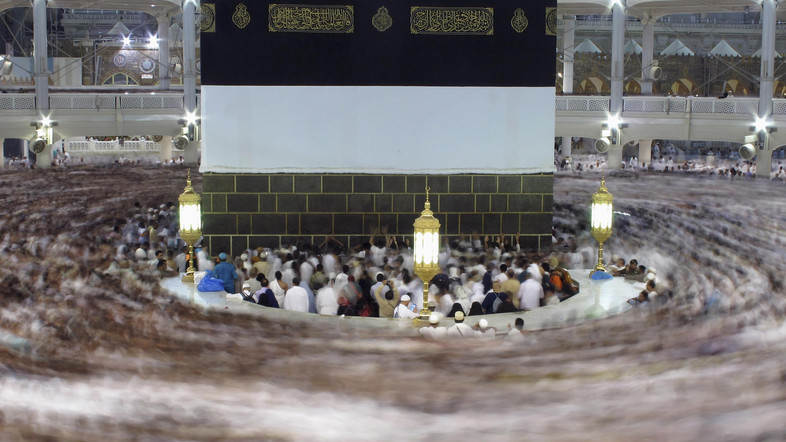Millions of Muslims this week flock to Islam’s holiest city of Makkah to perform the annual hajj pilgrimage. Being the fifth pillar of Islam, hajj or the act of making a pilgrimage is a mandatory religious duty for Muslims. Muslims are required to perform hajj at least once in lifetime if they have the physical and financial ability.
In it, pilgrims follow the footsteps of Prophet Ibrahim and his family.
For many pilgrims, hajj is perceived to be a journey of the body and the soul at the same time.
The first day of hajj is 8 Zil Hijjah, the last month of the Islamic calendar. The holy journey requires the pilgrim to perform ten rituals before and during hajj.
Here are the basic steps you may want to know about hajj:
State of Ihram: This is considered the first step for any pilgrim wishing to perform hajj. To enter the state of Ihram, a pilgrim has to recite an intention to perform hajj called the Talabiya. This is when a pilgrim prepares one’s soul, mind and body for journey to the Almighty God. Entering the stage begins from the Miqat, or a place that is outside the pilgrimage area.
Men and women going on hajj adhere to a specific dress code which is aimed at showing modesty and shedding all signs of wealth. Men don unstitched white garments, while women wear normal stitched clothes and a headscarf. Women are forbidden however from wearing the burqa or niqab.
In fact, the word Ihram originates from the Arabic term ‘Tahreem’, which means prohibited. Because the state is believed to have a special essence of spiritual purity, there are certain acts that are not allowed for pilgrims. Among them are using perfumes, cutting hair or nails, and slaughtering animals.
 Makkah: The Saudi Arabian city is considered Islam’s holiest site, as it holds al-Masjid al-Haram or the Grand Mosque that surrounds the Kaaba, a cuboid shaped building which Muslims believe has been put up together by Prophet Ibrahim and his son Ismail almost 4, 000 years ago.
Makkah: The Saudi Arabian city is considered Islam’s holiest site, as it holds al-Masjid al-Haram or the Grand Mosque that surrounds the Kaaba, a cuboid shaped building which Muslims believe has been put up together by Prophet Ibrahim and his son Ismail almost 4, 000 years ago.
Muslims call the Kaaba “the house of God” and are expected to face the direction of Makkah when praying in any part of the world.
Tawaf: Upon arrival to Makkah, Pilgrims should make Tawaf or circumambulation. It is considered an integral part of the pilgrimage, and refers to the seven times pilgrims circle around the Kaaba at the beginning, during and at the end of hajj.
The circuits are done in a counter-clockwise direction and are thought to express the unity between Muslims in worshipping one God. The rotations are marked by al-Hajar al-Aswad, or the Black Stone at the eastern corner of the Kabaa.
Sa’ey: To traverse the distance between the hills of Safa and Marwah for seven times, this is what is called Sa’ey. The term in Arabic means to walk or move quickly. After Tawaf, pilgrims perform Sa’ey, in what commemorates the journey by Prophet Ibrahim’s wife to find water for her infant prophet Ismail, after they were left in the desert of Makkah at God’s command. The hills are now enclosed by the Grand Mosque.
Departure to Mina: Pilgrims proceed to the tent city of Mina on the first day of hajj or what is called the day of Tarwiah. They converge to Mina for prayer, which lies roughly eight kilometers away from Makkah. Pilgrims are required to remain in Mina until the sunrise of the second day of hajj, where they leave to Arafat.
They pay another trip to Mina on the third day of hajj to perform the symbolic stoning of the devil, the sixth rite of hajj.
Mount Arafat: After the dawn prayers in Mina, pilgrims start their journey to the desert planes of Arafat. Dubbed as the “most important day of hajj,” Muslims spend the day of Arafat in the vicinity of the mountain, praying and repenting. The rituals of this day end at sunset, when pilgrims move to Muzdalifah.
Muzdalifah: After descending from Arafat, pilgrims arrive to the open land of Muzdalifah, southeast of Mina. People gather in makeshift tents and are required to perform Maghrib and Isha prayers. It is also considered the best place to collect pebbles for Ramy al-Jamarat.
Ramy al-Jamarat: The symbolic stoning of the devil, where pilgrims fling pebbles, called jamarat, at three walls, in the city of Mina. The stoning marks the third day of hajj or Eid al-Adha.
Eid al-Adha: The Eid al-Adha festival, or the Feast of Sacrifice, is celebrated by Muslims who are not on pilgrimage by slaughtering animals to mark Prophet Ibrahim’s willingness to sacrifice his son Ismail upon the command of God.
Pilgrims spend the three days of Eid stoning pillars that represent the devil. They later purchase tokens to have a sheep slaughtered in the Makkah neighbourhood of Mina.
[Source: Al Arabiya]





 WhatsApp us
WhatsApp us 

